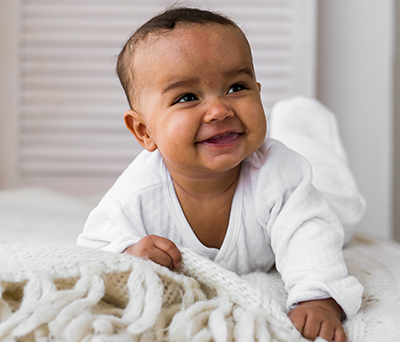
Your beautiful baby boy just turned two months old and you noticed his head was becoming slightly misshapen. The pediatrician confirmed this and diagnosed him with deformational plagiocephaly – which means asymmetrical head shape. This condition is a result of repeated pressure to the same area of the head – it may be flat across the back or one side. What caused this and what do you do now?
In the early 1990s, the “Back to Sleep” campaign educated parents about putting babies to sleep on their back to prevent suffocation and to reduce the risk of sudden infant death syndrome (SIDS). However, one adverse consequence of back sleeping lead to misshapen heads or plagiocephaly in babies.
Some babies develop plagiocephaly caused by external pressures and some are born with it. This includes babies who are premature, or were crowded in their mom’s uterus because they were a multiple birth, or whose birth was assisted with a forceps or vacuum extraction. Other causes may be due to muscular torticollis, which causes tight neck muscles so the baby only turns his or her head one direction to sleep.
Sybill Naidoo, RN, CPNP, is the nurse manager that runs the St. Louis Children’s Hospital’s Deformational Plagiocephaly Clinic. She says, “The good news is that plagiocephaly does not affect the baby’s brain or growth. It can be corrected through positioning or by wearing a helmet for a few months.”
“We do see more babies with this condition than we did 25 years ago because of back sleeping and the increased use of infant devices such as car seats, strollers, bouncy seats and swings that keep a baby continually on his or her back,” Naidoo says. “It used to be just a handful of babies were affected, but now we see about 800 to 900 babies each year with plagiocephaly.”
Any baby with a misshapen head should be evaluated to rule out more serious conditions such as craniosynostosis — a condition that occurs when the sutures between the skull plates fuse together too early, which limits space for brain growth. With either deformational plagiocephaly or craniosynostosis, early treatment (between two and four months of age) is important.
“If we see a baby early enough, we can often just use positioning to correct the head shape,” Naidoo says.
Positioning tips
Make sure your baby gets at least one hour of tummy time each day. This also strengthens neck and arm muscles while improving motor skills.
When you’re out and about, leave the car seat in the car. Carry your baby in a front carrier or sling — this eases the continuous pressure on the back of your baby’s head.
Choose different positions and ways to hold your baby. Switching arms when cradling and try the “football hold”.
Limit time in swings and bouncy seats, which also put pressure on the back of the head.
Develop motor skills and play with babies to get them rolling, crawling, pushing, pulling, reaching, holding and grasping.
For naps and sleeping at night, put the baby at the opposite end of the crib from the nap or night before. The baby will naturally face outward so pressure points are alternated.
Helmet help
If positioning does not help, after about four months of age, or if the baby’s head is severely misshapen, the baby may need to wear a helmet for treatment. Helmets are custom-made for each baby and are usually worn 22 hours a day for about three to six months — depending on the age of the baby and severity of the flattening.
The helmet is lightweight with outer hard shell and foam lining. It works by applying gentle, persistent pressure to the wider parts of the head while space is built into the helmet over flatter areas to capture the natural growth of an infant’s head. As the head grows, adjustments are made to the helmet every few weeks.
“Babies are very resilient to change and adjust well to wearing the helmet,” Naidoo says. “The idea of wearing a helmet is harder on the parents.”
For more information, or to make an appointment at the St. Louis Children’s Hospital Deformational Plagiocephaly Clinic, please call 314-454-KIDS (5437).
St. Louis Children’s Hospital
1 Children’s Place
2nd floor, Suite A
St. Louis, MO 63110
Children’s Specialty Care Center
13001 South Outer 40
2nd floor, Suite D
Town and Country, MO 63017